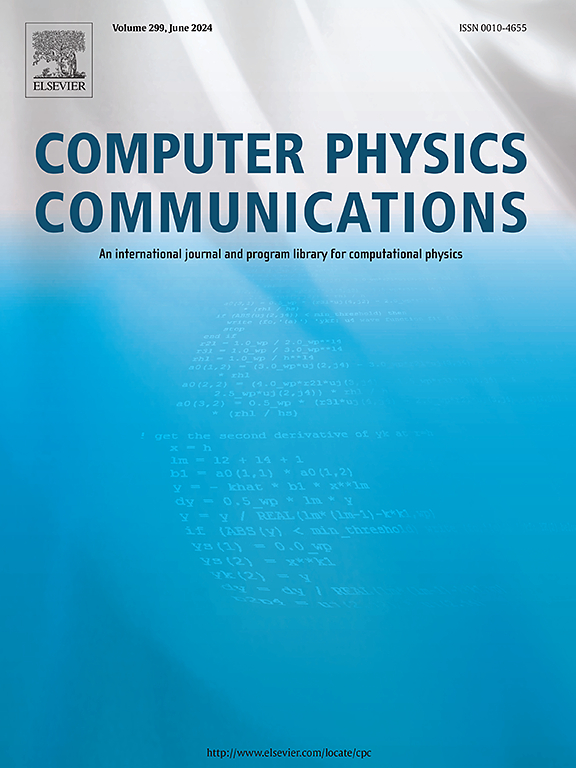On-the-fly clustering for exascale molecular dynamics simulations
IF 7.2
2区 物理与天体物理
Q1 COMPUTER SCIENCE, INTERDISCIPLINARY APPLICATIONS
引用次数: 0
Abstract
Computational resources have experienced exponential growth in the last decades enabling the simulation of complex physical problems at the cost of a massive increase in data storage. This is especially true for N-body simulations now reaching billions or trillions particles in certain cases. To overcome the drawbacks of data storage on disk for post-processing purposes, on-the-fly analysis has gained momentum but still represents a challenge in both its implementation and efficiency without impacting the simulation engine performances. This work provides a new in-situ procedure for features detection in massive N-body simulations, leveraging state-of-the-art techniques from various fields. Based on a discrete-to-continuum paradigm shift, particles and their respective physical quantities are projected onto a 3D regular grid before applying image analysis algorithms to group voxels based on specific user-defined criteria. A significant extension to the hybrid parallelism of connected component analysis within the image processing community is also introduced in the present study. Traditionally operating in shared memory parallelism, this extension now incorporates both distributed and shared memory approaches. The implementation is carried out within the exaStamp classical Molecular Dynamics code, a variant of the open-source exaNBody platform [39]. This adaptation allows for the on-the-fly analysis of multi-billion atoms samples with at most a 1.3% overhead. In addition, the entire framework is benchmarked up to 32768 cores. The applicability of the present approach is demonstrated on the case of a spall fracture in a tantalum sample as well as high velocity impact of a tin droplets on a rigid surface.
超大规模分子动力学模拟的即时聚类
过去几十年来,计算资源呈指数级增长,使复杂物理问题的仿真以数据存储量的大量增加为代价。在某些情况下,N-体模拟的粒子数量已达到数十亿或数万亿,这一点尤为明显。为了克服将数据存储在磁盘上进行后处理的弊端,实时分析技术的发展势头迅猛,但在不影响仿真引擎性能的前提下,其实施和效率仍然是一个挑战。本研究利用不同领域的先进技术,为大规模 N-body 模拟中的特征检测提供了一种新的原位程序。基于离散到连续的范式转换,粒子及其各自的物理量被投射到三维规则网格上,然后应用图像分析算法,根据用户定义的特定标准对体素进行分组。本研究还对图像处理领域中的连通成分分析混合并行性进行了重大扩展。传统上是在共享内存并行模式下运行,现在这一扩展结合了分布式和共享内存两种方法。实施工作在 exaStamp 经典分子动力学代码中进行,该代码是开源 exaNBody 平台的一个变体[39]。通过这种调整,只需 1.3% 的开销就能对数十亿原子样本进行即时分析。此外,整个框架的基准可达 32768 个内核。本方法的适用性在钽样品的剥落断裂以及锡滴对刚性表面的高速冲击中得到了验证。
本文章由计算机程序翻译,如有差异,请以英文原文为准。
求助全文
约1分钟内获得全文
求助全文
来源期刊

Computer Physics Communications
物理-计算机:跨学科应用
CiteScore
12.10
自引率
3.20%
发文量
287
审稿时长
5.3 months
期刊介绍:
The focus of CPC is on contemporary computational methods and techniques and their implementation, the effectiveness of which will normally be evidenced by the author(s) within the context of a substantive problem in physics. Within this setting CPC publishes two types of paper.
Computer Programs in Physics (CPiP)
These papers describe significant computer programs to be archived in the CPC Program Library which is held in the Mendeley Data repository. The submitted software must be covered by an approved open source licence. Papers and associated computer programs that address a problem of contemporary interest in physics that cannot be solved by current software are particularly encouraged.
Computational Physics Papers (CP)
These are research papers in, but are not limited to, the following themes across computational physics and related disciplines.
mathematical and numerical methods and algorithms;
computational models including those associated with the design, control and analysis of experiments; and
algebraic computation.
Each will normally include software implementation and performance details. The software implementation should, ideally, be available via GitHub, Zenodo or an institutional repository.In addition, research papers on the impact of advanced computer architecture and special purpose computers on computing in the physical sciences and software topics related to, and of importance in, the physical sciences may be considered.
 求助内容:
求助内容: 应助结果提醒方式:
应助结果提醒方式:


